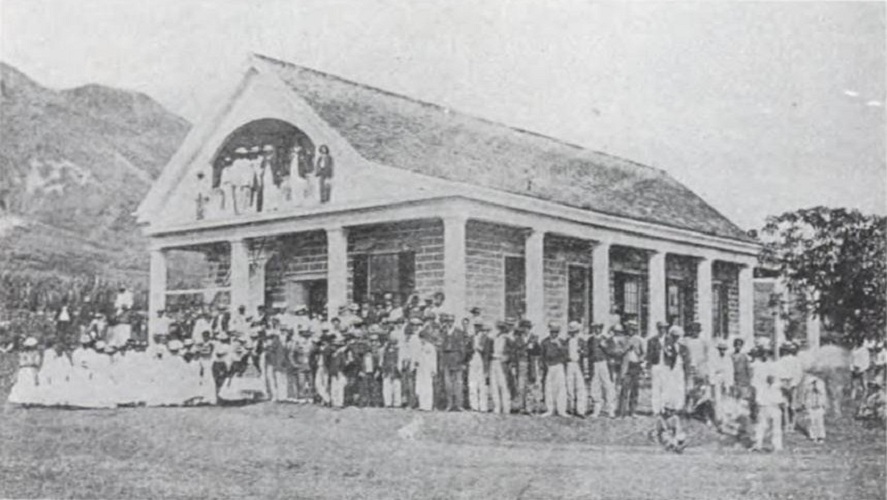“The American Public School system comprises in most of the states twelve grades, occupying the children between the ages of 6 and 12. These grades are thus denominated: First to Fourth Primary, Fifth to Eighth Grammar, Ninth to Twelfth High.”
“A slight departure from this scheme of classification is made in the Territory. Here, though maintaining the same twelve grades, as in the states, they are divided in six grades in the Primary School, and six grades in the High School.”
“The curriculum of the grades nine to twelve inclusive corresponds to that of the same grades in the schools on the mainland.” (Hilo Tribune, Sep 10, 1907)
Without a high school on the Island of Hawai‘i, “It has been the habit of solicitous parents of this island during the past century to send their children to the schools of Honolulu, for whatever education they received beyond the grammar grades. It is needless to say that this necessity has entailed both anxiety and expense.”
“Thus it became an object with the teachers and parents of Hilo to secure in their midst sufficient advantages to return their children at home.” (Hilo Tribune, Sep 10, 1907)
A High School in Hilo had a shaky start. After passage in 1903, but failing to receive the Governor’s signature, in a February, 1905 session of the legislature, “Under suspension of the rules, Senator [John T] Brown introduced a bill (S. B. No. 23) entitled ‘An Act to Provide for a High School in Hilo, Island and Territory of Hawaii, under the Department of Public Instruction of the Territory.’”
The proposed legislation, again, passed through the legislature. When presented to Governor Carter and Carter stated, “I am unable to approve”, citing that “This bill falls within that class of absolutely unnecessary legislation.” On April 18, 1905, the legislature overrode the Governor’s veto.
“A special committee of the Board of Education … held a conference with Superintendent Davis and Normal Inspector King when the plans for putting the high school in operation were discussed.”
“The problem before the Commissioners was whether they should start the High School work of Hilo at the beginning of the next school year as a separate organization or wait until the new High School building was erected and then begin the independent organization.” (Hilo Tribune, July 18, 1905) It was decided to start sooner than later.
“In Sept. 1905 a class of twenty pupils was excellently fitted to begin their secondary studies. … Room for its reception was made in the Union School, where, despite much painful crowding, very efficient work was accomplished.” (Hilo Tribune, Sep 10, 1907)
“The Hilo High School began its career under that apellation on Sept. 6, 1905, under the direction of Mr. FA Richmond (‘a Stanford graduate and has been vice principal of the Honolulu High School’), CO Smith and Miss MP Potter.”
A site was needed. “At a meeting of the Board of Trade … it was decided to recommend the Riverside school site for the new Hilo High School, and to remove the present Riverside school to the Masonic Hall lot opposite”. (Hilo Tribune, July 18, 1905)
“There were in the schools of Hilo nine grades – the beginning with Ninth being the only grade entitled by usage in the States to be called High School. However, grades Seven, Eight and Nine were assembled under the High School teachers, and proceeded to work in two of the upstairs rooms of the Hilo Union School.”
“Since that time two new grades have entered the High School, and the original students no constitute grades Nine, Ten and Eleven. One year from now the present eleventh grade will graduate as the 1908 Twelfth Grade. And the curriculum of the school will be completely taught.” (Hilo Tribune, Sep 10, 1907)
“The first class will be given (1) what is known as ‘first year Latin,’ to prepare the students to read Caesar; (2) English, comprehending correct composition, rather than criticism; (3) History-Ancient Greek and Roman; (4) Physical Geography; (5) Algebra, through quadratics, and (6), the study of some language, either French or German.” (Hilo Tribune, Aug 29, 1905)
“The work of the High School has been shaped to fit carefully local needs. Such students as feel the need of immediately getting into business will be given a Commercial Course in book keeping, typewriting, shorthand, commercial arithmetic, court reporting, etc.”
“Such students as have expectations of colleges will be given careful preparation for entrance to the best American colleges and Universities.” (Hilo Tribune, Sep 10, 1907)
The new school building opened September 9, 1907. “The Hilo high school has four good, well-lighted and ventilated rooms downstairs, capable of accommodating 160 pupils. There are six rooms upstairs there 100 additional pupils can receive instruction … The room for the commercial class is well equipped.” (Advertiser, September 7, 1907)
Hilo High’s first graduating class consisted of seven students in 1909: Richard Kekoa, Amy Williams, Eliza Desha, Frank Arakawa, John Kennedy, Annie Napier and Herbert Westerbelt. (Mangiboyat)
Hilo High Auditorium was built in 1928. It was donated to the school by the Alumni Association. It was designed by a former student (and part of the first graduates) of Hilo High School, Frank Arakawa.




































